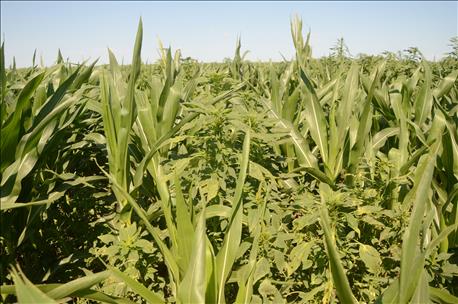
As Jeff Goldblum's character Ian Malcolm put it in Jurassic Park, "Life finds a way." As many familiar with the franchise know, Malcolm was talking about how, despite our best efforts, nature finds a way to survive and even thrive under the pressures of man. More specifically, he was talking about the all-female dinosaur population on Isla Nublar.

ZERO TOLERANCE: This is a Palmer amaranth-infested field near Shickley. Jason Norsworthy encourages growers to adopt a zero-tolerance policy when it comes to managing Palmer amaranth.
As it turns out, resistance also finds a way into weed populations — and that doesn't just mean resistance to herbicides. As University of Arkansas weed scientist Jason Norsworthy pointed out at a recent Resistant Palmer Amaranth Field Day near Shickley last week, barnyardgrass has been identified in China that resists hand-pulling by mimicking rice until it's too late to pull.
Of course, this was after 300 years of evolutionary selection, and 300 years of manually pulling barnyardgrass from rice paddies. As Norsworthy pointed out, if you put that much selection pressure on a weed through any one method of control — whether mechanical, chemical or manual — chances are you'll likely see resistance develop before long.
Weeds that develop resistance to hand-pulling might sound like something out of an agricultural horror story, but what about weeds that put farmers out of business? Norsworthy brought up more than one example of that most infamous weed of the South, Palmer amaranth, doing exactly that.
In Norsworthy's part of the world, Palmer amaranth has developed what he calls "stacked resistance" — that is, resistance to multiple modes of action and multiple active ingredients. This leaves farmers with few if any options to control Palmer outside of taking a disk to the field.
That's one of the reasons Norsworthy advocates for a zero-tolerance policy when it comes to managing Palmer amaranth — or any weed for that matter. Even if any single mode of action remains effective against a particular weed species, it's not a good idea to give it a chance to develop resistance. The best route is to start clean and stay clean, using multiple effective modes of action: starting with a preemerge herbicide, following up with a post, and overlapping residual.
Even seeing one lone weed out in the field warrants a hand-pulling. That's especially true for Palmer amaranth — on average, a single Palmer plant can produce 60,000 seeds. Once a weed becomes resistant, it doesn't become susceptible again. Give Palmer amaranth, or any weed, a chance to survive, and life will find a way.
About the Author(s)
You May Also Like






